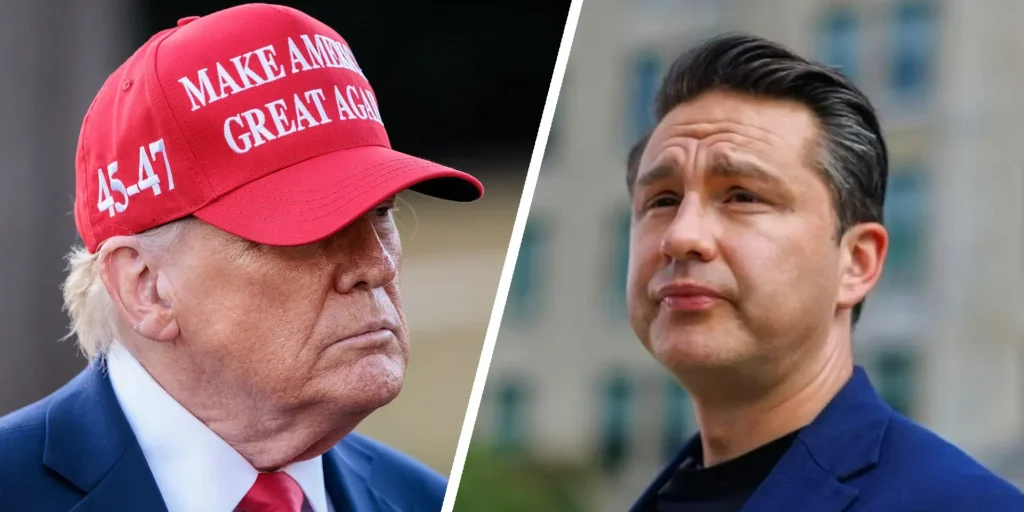Pierre Poilievre’s election loss marked a significant turning point in his political journey, as he faced not only the defeat in the polls but also the potential loss of his residence. The Ottawa election results revealed an unexpected outcome, with Liberal candidate Bruce Fanjoy emerging victorious by approximately 4,300 votes, a stark contrast to Poilievre’s previous wins. This defeat has sent shockwaves through Conservative Party news, raising questions about the party’s future and leadership dynamics. As Poilievre navigates the by-election implications of this loss, he must also consider finding a new home for his family, having temporarily resided in Stornoway, the official residence of the Leader of the Opposition. The impact of this election loss extends beyond mere numbers; it signifies a need for reflection and adaptation within the Conservative Party to regain its footing in the political landscape.
The recent defeat of Pierre Poilievre signifies more than just a loss at the polls; it reflects the shifting tides within Canadian politics. Following the Ottawa results where Bruce Fanjoy of the Liberal Party triumphed, questions arise about the Conservative Party’s strategies moving forward. With the implications of by-elections looming, Poilievre’s next steps will be crucial in determining his political viability and the party’s direction. This transition also raises the stakes for Poilievre personally, as he faces the reality of vacating the taxpayers’ funded residence that comes with the leadership role he no longer holds. As the Conservative Party reevaluates its approach, Poilievre’s ability to adapt and respond to this electoral challenge will undoubtedly shape the narrative of his political comeback.
The Aftermath of Pierre Poilievre’s Election Loss
Pierre Poilievre’s recent election loss has significant implications for both his political career and personal life. After losing his seat in the House of Commons to Liberal candidate Bruce Fanjoy, who won by approximately 4,300 votes, Poilievre faces immediate challenges, including vacating Stornoway, the official residence for the Leader of the Opposition. This loss represents not just a defeat in the political arena but a personal upheaval as he and his family must find a new home after having lived in the taxpayer-funded residence since he took on the leadership role.
This election defeat comes at a critical juncture for the Conservative Party, as Poilievre had been praised for revitalizing the party with promises of significant change. However, despite his efforts to increase support in traditionally Liberal strongholds, he only managed to secure 41.3% of the vote, which underscores the shifting dynamics within Canadian politics. His loss highlights the necessity for the Conservative Party to reevaluate its strategies moving forward, particularly as they prepare for potential by-elections and future elections.
Bruce Fanjoy’s Victory: A Turning Point for the Liberals
The election victory of Bruce Fanjoy over Pierre Poilievre is a pivotal moment for the Liberal Party, marking a successful attempt to reclaim a seat that had been held by Conservatives since 2004. Fanjoy’s active campaigning contributed significantly to higher voter turnout, enabling him to achieve 43.7% of the votes. This victory not only solidifies his position but also symbolizes a broader trend of Liberals regaining ground in several Ottawa-area ridings, indicating a potential resurgence for the party as they look ahead to future elections.
Fanjoy’s triumph reflects a shift in the electorate’s priorities and preferences, which could pose challenges for the Conservative Party. The implications of this election outcome could extend well beyond the immediate political landscape, potentially impacting party strategies and future candidate selections. With Poilievre out of the picture, the Liberals might capitalize on this momentum to strengthen their foothold while the Conservatives scramble to regroup and redefine their message to appeal to the voters who favor changes.
Implications of By-Elections for the Conservative Party
The loss of Pierre Poilievre’s seat has raised important questions for the Conservative Party regarding the future of their leadership and representation in the House of Commons. A return to Parliament for Poilievre hinges on the results of by-elections that may be called in the aftermath of this election. Should a newly elected representative choose to step down, it would create an opportunity for Poilievre to contest a by-election and reclaim his position. However, the timing of such calls depends on the Prime Minister, who has the discretion to wait up to six months, increasing the uncertainty around Poilievre’s immediate political future.
This situation not only affects the individual prospects of Poilievre but also the overall strategy of the Conservative Party. With concerns about his capability to regain a parliamentary seat, party members are left pondering how they will navigate the upcoming months and maintain the party’s strength in light of recent setbacks. As the party looks for ways to adapt and prepare for potential by-elections, addressing the underlying issues that contributed to the election loss will be crucial for their success in future contests.
Understanding the Voter Dynamics Behind the Election Results
The recent election results, which saw Bruce Fanjoy securing victory over Pierre Poilievre, reveal significant shifts in voter dynamics within the Ottawa region. The higher voter turnout in this election indicates a renewed civic engagement that previously leaned towards the Liberal Party, challenging the long-standing support for the Conservatives. Factors contributing to this shift may include changing demographics in ridings that Poilievre once dominated and growing discontent with the traditional conservative messaging.
Additionally, the focus on local issues, along with grassroots campaigning by candidates like Fanjoy, seems to resonate more with voters than the broader national strategies presented by Poilievre’s campaign. This underscores the importance of listening to constituents’ needs and adapting to their evolving preferences to maintain electoral viability. Going forward, both the Conservative Party and its leadership must pay keen attention to these emerging trends if they hope to regain lost ground and foster perseverance in future elections.
Reactions from Conservative Party Members to the Loss
The reaction from members of the Conservative Party following Pierre Poilievre’s election loss has been mixed, as many rally around their leader despite the setback. Acknowledging the need to learn from this defeat, members have expressed a desire to regroup and reassess their strategies. While some show concern regarding party direction, Poilievre remains a popular figure, retaining the support of a multitude of Conservative loyalists who appreciate his approach to uniting the party and addressing the issues pertinent to their constituents.
Despite the disappointment, there are pockets of optimism within the ranks as party members acknowledge that Poilievre’s campaign did achieve certain milestones, such as increasing their overall seat count and appealing to new demographics. This duality of disappointment and encouragement reflects a resilient spirit among Conservatives, as they prepare for the challenges ahead and aim to turn their fortunes around in the face of the recent electoral defeat.
Evaluating Poilievre’s Campaign Strategies
Pierre Poilievre’s campaign strategies leading up to the recent election are now under scrutiny, especially in light of his defeat. While he effectively attracted large crowds to his rallies and secured endorsements from local unions and police associations, these efforts were not enough to clinch victory. Critics have suggested that his platform may not have addressed the pressing concerns of the Ottawa electorate, leading to a disconnect that the Liberal Party successfully capitalized on.
Moreover, his promise of change resonated with long-time Conservatives, yet the party’s inability to innovate and adapt to emerging political trends ultimately proved detrimental. As the Conservative Party evaluates Poilievre’s strategies, it will be crucial for them to consider more inclusive platforms that resonate with a wider audience. The lessons learned from this campaign period will shape future elections and leadership approaches in an evolving political landscape.
The Role of Local Issues in the Ottawa By-Election
Local issues played a crucial role in the Ottawa by-election that resulted in Pierre Poilievre’s loss to Bruce Fanjoy. Voters in the riding were deeply concerned with matters that directly impacted their community—such as healthcare access, housing affordability, and transportation infrastructure. Fanjoy’s campaign prioritized engagement with these local issues, allowing him to resonate with constituents and present a strong alternative to Poilievre’s more nationally-focused rhetoric.
As local concerns take center stage, it becomes increasingly clear that candidates must connect their platforms to the everyday experiences of voters. The implications of this shift in focus could create new pathways for the Liberal Party, allowing them to build momentum and solidify their presence in once Conservative-dominated areas. Moving forward, the Conservative Party must recognize the importance of local issues in their campaigning efforts to recapture lost seats and adapt to the changing electoral climate.
Future Prospects for Pierre Poilievre’s Political Career
Looking ahead, the future prospects of Pierre Poilievre’s political career hinge on how he navigates the aftermath of his election loss. While the immediate focus is on potentially reclaiming a seat through a by-election, his overall image within the party and the public perception will be critical to his resurgence. His popular appeal within the Conservative base could provide him with opportunities to forge alliances and garner support for a future campaign, particularly if he can demonstrate adaptability in response to recent feedback.
Regardless of the challenges he currently faces, Poilievre’s experience and political acumen are assets that could play an essential role in revitalizing his leadership position. As he formulates a strategic response to his electoral defeat, maintaining transparency, humility, and an inclusive approach could help him reestablish trust with voters and party members alike. The path to reclaiming lost confidence will require thoughtful reflection on past strategies and a focus on addressing the concerns of Canadians moving forward.
Impact of Political Endorsements on Poilievre’s Campaign
During the lead-up to the election, Pierre Poilievre benefited from endorsements by key organizations, including local unions and police associations, which bolstered his campaign’s credibility. However, despite these endorsements, Poilievre faced challenges in translating this support into votes, ultimately culminating in his loss to Bruce Fanjoy. The disconnect between supportive endorsements and voter turnout highlights the complexities of modern political campaigns, where endorsements do not always guarantee electoral success.
Moving forward, the Conservative Party may need to reassess their reliance on traditional endorsements and focus more on grassroots engagement. Engaging voters on a personal level and addressing their unique concerns could potentially offset the impact of missed endorsements in future campaigns. As Poilievre reflects on the past election, understanding the nuanced relationship between endorsements and voter perceptions will be crucial for forming successful strategies in the future.
Frequently Asked Questions
What led to Pierre Poilievre’s election loss in the Ottawa area?
Pierre Poilievre lost his seat in the Ottawa-area riding to Liberal candidate Bruce Fanjoy by approximately 4,300 votes. The election results showed higher voter turnout, which favored the Liberals this time despite Poilievre’s previous winning streak.
What are the implications of Pierre Poilievre’s election loss for the Conservative Party?
Poilievre’s election loss has significant implications for the Conservative Party, as it raises concerns about party leadership and strategies moving forward. It emphasizes the need for the party to learn from this setback and potentially reassess their campaign tactics in future elections.
How did Pierre Poilievre’s concession speech reflect on his election loss?
In his concession speech, Pierre Poilievre acknowledged the need for the Conservatives to learn from their election loss while also highlighting positives such as gaining seats in other regions. This balanced approach suggests he is focused on future challenges and adapting the party’s strategies.
What happens to Pierre Poilievre’s position after losing his seat in the election?
After losing his seat, Pierre Poilievre is no longer recognized as the official Leader of the Opposition, which means he will have to vacate the Stornoway residence and lose associated funding, including a $215,090 budget for residence staff and services.
What are the prospects for Pierre Poilievre to regain a seat after his election loss?
To regain a seat after his election loss, Pierre Poilievre would need a currently elected member to step aside, triggering a by-election. However, the timing of such a by-election is determined by the Prime Minister, which adds uncertainty to Poilievre’s path back to Parliament.
How does higher voter turnout during the election affect Pierre Poilievre’s loss?
Higher voter turnout likely played a crucial role in Pierre Poilievre’s election loss, as it favored the Liberal candidate Bruce Fanjoy. This trend indicates a shift in voter engagement and priorities, suggesting challenges for the Conservatives in future campaigns.
What strategies did Pierre Poilievre employ in his campaign leading up to his election loss?
In his campaign, Pierre Poilievre focused on promises of change and mobilized significant grassroots support, attracting crowds to his rallies. Despite these efforts, his campaign could not secure enough votes, illustrating the complexities of engaging voters effectively.
What was the primary reason for Bruce Fanjoy’s victory over Pierre Poilievre?
Bruce Fanjoy’s victory over Pierre Poilievre can be attributed to a combination of active campaigning and increased voter turnout in the riding, which ultimately shifted the electoral balance away from the established Conservative stronghold.
| Key Point | Details |
|---|---|
| Pierre Poilievre’s Defeat | Lost his seat to Liberal Bruce Fanjoy by approx. 4,300 votes. |
| Home Loss | No longer recognized as Leader of the Opposition, must vacate Stornoway. |
| Financial Losses | Loses $215,090 residence budget and $2,000 vehicle allowance. |
| Return to Parliament | Needs a new seat and by-election after a party member steps down. |
| Election Date | April 29, 2025, amid higher voter turnout favoring Liberals. |
| Campaign Promises | Focused on change; obtained 41.3% of votes vs. Liberals’ 43.7%. |
| Concession Speech | Acknowledged need to learn from losses but highlighted increase in seat count. |
| Popularity | Despite loss, remains popular among Conservatives with strong rally attendance. |
Summary
Pierre Poilievre’s election loss has profound implications for his future in politics and personal circumstances. Losing his seat in the Carleton riding has not only displaced him from the House of Commons but has also affected his living situation, as he will have to vacate the Stornoway residence. With the Liberal candidate Bruce Fanjoy emerging victorious, Poilievre faces the challenge of securing a new seat through a by-election. This defeat highlights the need for reflection within the Conservative Party, as they strategize to regain their footing after this setback.



